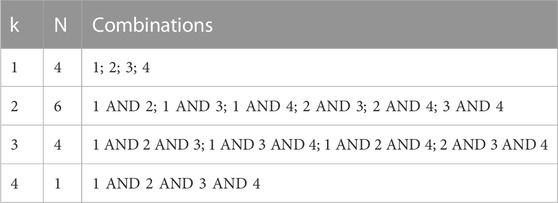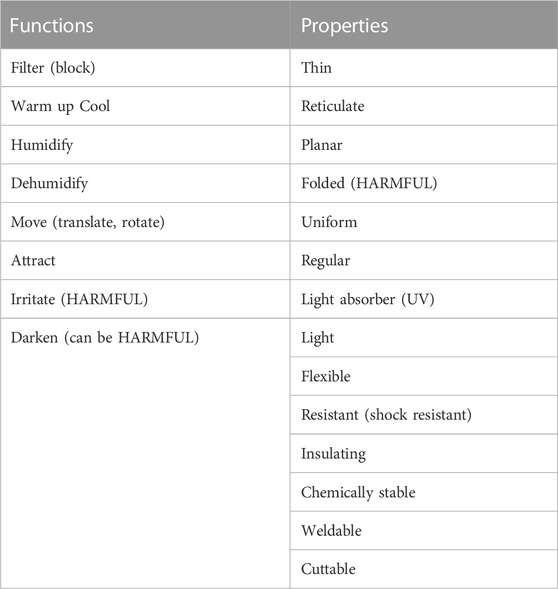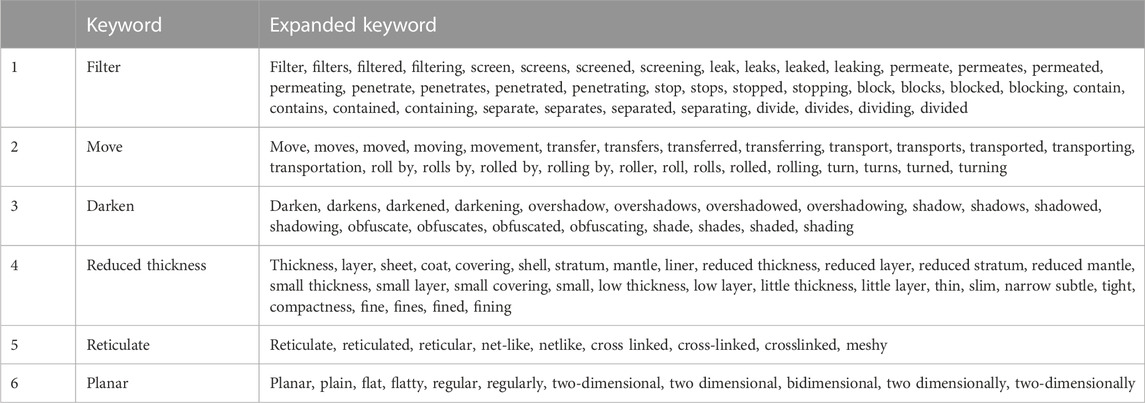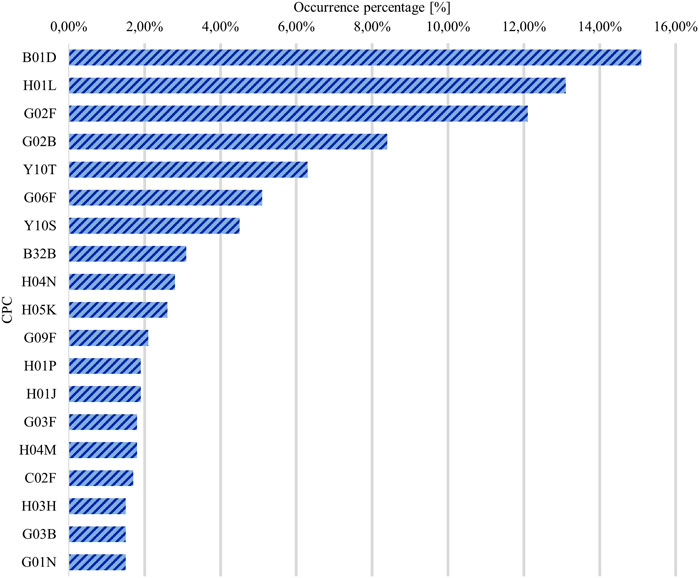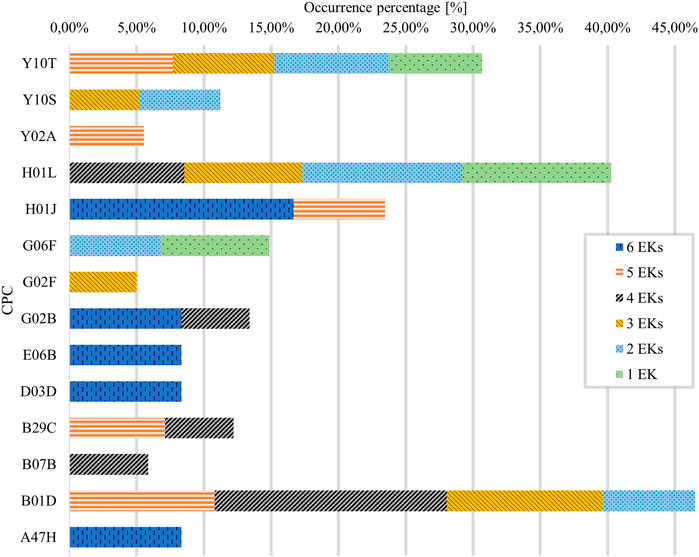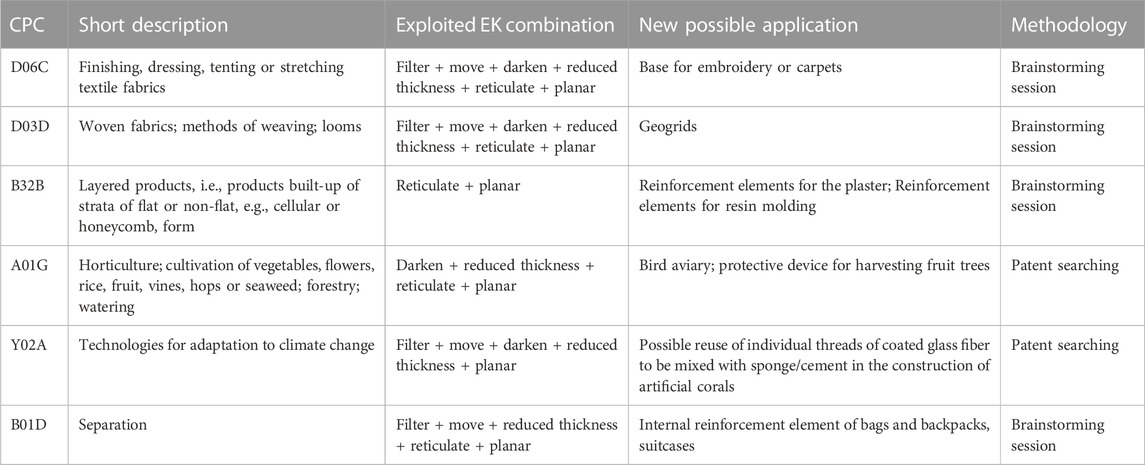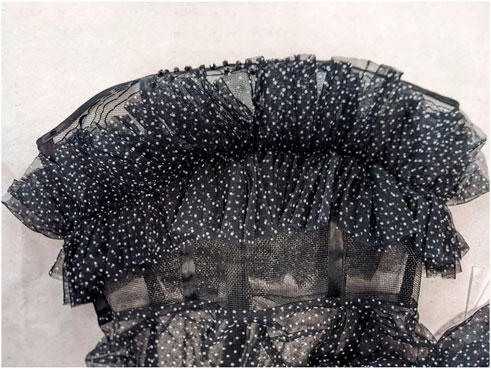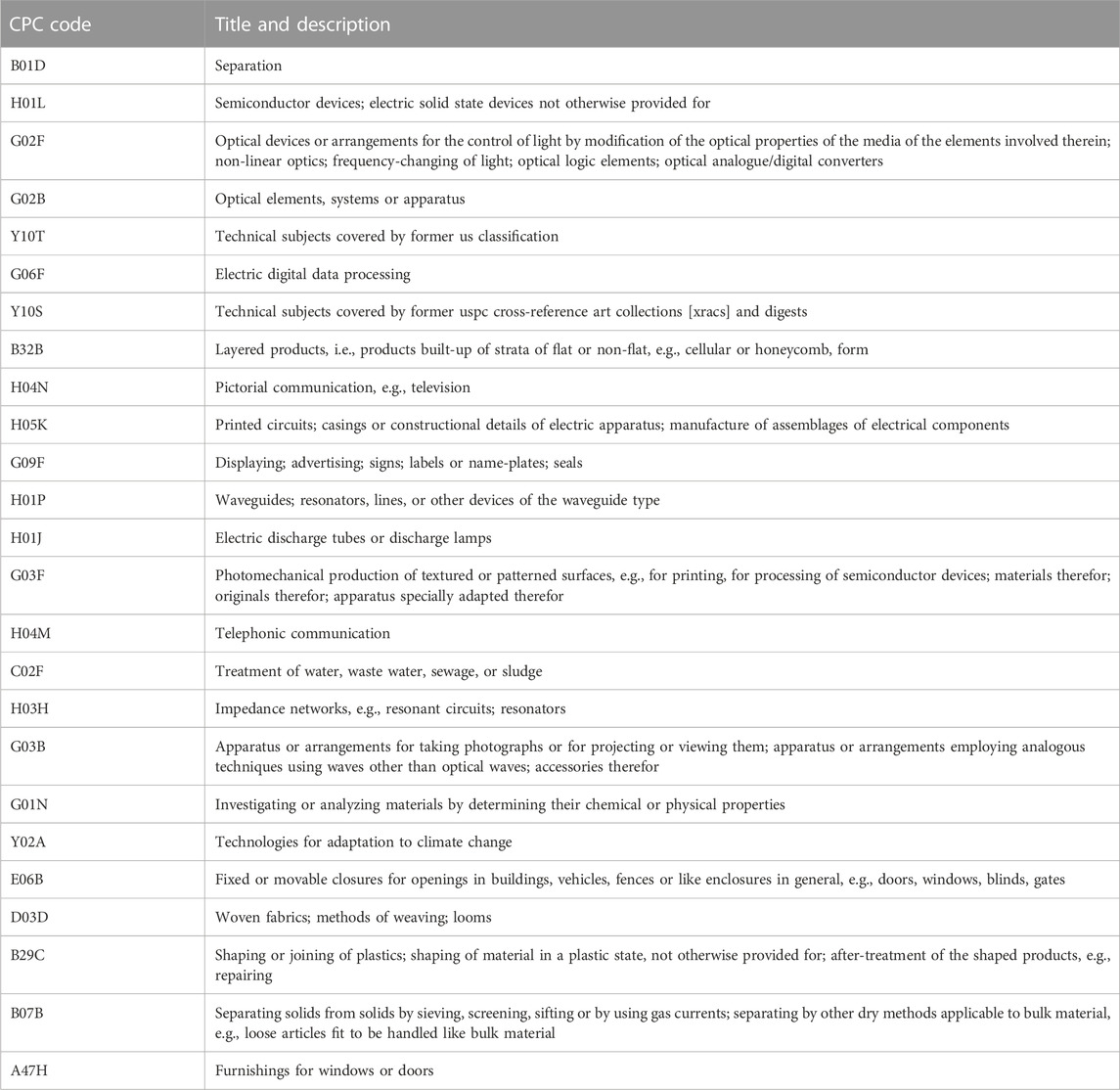End of life of mosquito nets: searching for alternative uses through patent classification
- 1Department of Industrial Engineering, University of Florence, Florence, Italy
- 2Palagina s.r.l, Florence, Italy
The effects of global concerns such as climate change and environmental pollution must be considered also when dealing with the design or revamping of products or services nowadays. Existing practices, such as the 3R recovery approach and the Circular Economy approach, which aim to reduce waste and increase recycling, regeneration, and reusability, need to be applied during this process. This paper is embedded in this context, and it presents a study that was conducted within a manufacturing company on the possibility of reusing end-of-life mosquito nets, which are difficult to recycle, with the aim of reducing their environmental impact and creating new business opportunities. To achieve this goal, several methods for identifying new product applications have been evaluated from the literature and the most suitable one has been selected. The method is based on the identification of the product functions; then, with a series of patent searches, the Cooperative Patent Classifications (CPCs) of the resulting patents are extracted to be used as external stimuli during the design process. The results obtained in terms of ideas generated are then shown at the end of the paper, suggesting the actual effectiveness of the method applied.
1 Introduction
Everyone agrees that global issues such as climate change and environmental pollution cannot continue indefinitely. Therefore, these effects must always be considered as possible consequences of our actions, especially in the industrial sector and, in particular, when designing or redesigning products or services (Kamp Albæk et al., 2020). Indeed, the UN’s 2030 agenda for prosperity, growth and safeguarding the planet includes a focus on sustainable production and consumption patterns, with seventeen different goals to be pursued (The Global Movement for Our Children’s Future - World Top 20 Project, 2022). Among such goals, the need to produce less waste in a conscious way and, when possible, to recycle, regenerate, or reuse the waste produced (UNRIC United Nations Regional Information Centre, 2019) is of paramount importance. The good practices aiming at the aforementioned targets take the name of the “3R recovery approach” (Moreno et al., 2016) and fall within the wider, and more complex, Circular Economy approach. According to these principles, attention must be given to the way products and goods are designed, not only looking at the environmental impact of a single stage of the product life but rather at all phases of the entire life cycle thought as a closed loop, i.e., from cradle to cradle (McDonough & Braungart, 2010). Accordingly, the possibility of multiple reuses of the same object, e.g., after going through a repairing or reconditioning phase, as well as the idea of finding different uses for a designed product and the material recycling scenario, should be considered since the beginning phases of design. For all these purposes, and especially for the latter one, the importance of avoiding, among others, difficult materials to be recycled and toxic chemicals is particularly relevant.
To reduce the environmental impact of an existing product, the more efficient and suitable strategy (or strategies) to follow depends on the type of product being rethought and its actual life cycle. If the design for sustainability approach (Moreno et al., 2016) has not been taken into account at all from the beginning, some strategies can be very hard or even counterproductive to pursue. For instance, if different materials are welded or bonded together, the recycling process can be challenging and not economically or environmentally viable.
In this scenario, the most practical strategy may be to reuse (Bocken et al., 2016) all or part of the product as-is after disassembly (Crowther, 1999) or after reconditioning. The study reported in this paper is set in this context, focusing on identifying possible reuse strategies for a product that already exists on the market: mosquito nets. These are mainly composed by the following components: painted aluminum profiles, plastic elements, small metal parts and various types of nets. The most commonly used nets are made of a composite material with long filaments of glass fiber covered by a plastic polymer (PVC). This study focuses on this type of net, which is notoriously difficult to recycle compared to the other materials used in mosquito nets. Broadly speaking, reuse can take place either for the same purpose for which the material was designed or in completely different areas. In the latter case, the possibilities are manifold. It is up to the designers to determine, based on their experience, which field is more feasible than others.
Unfortunately, the mosquito net manufacturing company where this study was conducted, although aware of the environmental problems of the nets at their end-of-life, had never carried out any specific study to reduce their impact. This was mainly due to the lack of a supporting method for dealing with this problem within the company and the staff’s unawareness about how to effectively manage it.
In order to provide a methodological support for identifying possible fields of reuse for a given asset or one of its parts, various strategies can be found in the scientific literature (Zwicky, 1967; Beitz et al., 1996; Smith, 1998; Gadd, 2011; Fantoni et al., 2013; Gonçalves et al., 2014; Srinivasan et al., 2018; Tauqeer & Bang, 2020). These methods help users/designers decompose the problem into smaller, more manageable and replicable steps, and give a metric of how deeply the research has been performed for further future investigation. At the same time, as widely demonstrated in the literature (Crowther, 1999), the application of methodological tools is crucial to evaluate design choices and raise awareness of both the actual success and the creativity level achieved. This always keeping in mind the sustainability challenges, that acts both as constraint and as goals for the product development (Maccioni et al., 2021).
Based on the considerations outlined above, the main aim of this study is to provide an example of how one methodology found in the literature (Fiorineschi et al., 2018) can be used in an industrial context to identify possible alternative product uses: firstly, to reduce the environmental impact of the product at the end of its life cycle, and secondly, to create new business opportunities for the company. The selected method provides systematic hints based on the patent classifications definitions, which should leverage the creative process of the designer when she/he is thinking to new applications for exhausted products. Moreover, as interesting results have been obtained, this work serves as an example for those who wish to implement a similar approach in future applications.
The structure of the paper is as follows: first, a brief overview of contributions already existing in literature for helping designers to develop new products or to improve them is provided, highlighting their limitations, and explaining why the specific method has been chosen in this study. Next, a detailed explanation of the selected method is provided. Then, this method is applied to the specific industrial case, presenting the results obtained. Discussions and conclusions follow in the last chapter.
2 Literature review
To support the designer in the conceptual design phase during the development of a new product, several methodologies, checklists, and guidelines from different fields exist in the literature. These, mainly aim to provide various types of stimuli to increase the designer’s creativity, helping him/her to generate new ideas and explore the design space more systematically.
According to Smith (Smith, 1998), idea generation techniques are always based on the so-called active ingredients, which enable the user to activate certain cognitive activities. These may be based on instructions to be carried out by the user and/or on external stimuli or on particular conditions (e.g., anonymity). Active ingredients are divided into 15 macro-categories (Smith, 1998). The methods that are the subject of this analysis are derived from these and fall under the categories of both analytical and search strategies.
Among the analytical strategies, one of the most relevant is the so-called “morphological analysis” (Zwicky, 1967), an approach carried out to understand the structural interrelationships between objects, phenomena and concepts. “Functional analysis” (Gonçalves et al., 2014) then belongs to the same category; this approach, which decomposes the problem to be solved through an abstraction process, focuses on what the product will have to do and how it will do it, regardless of how it should appear externally. This is performed through the definition of the important concept of “function”.
There are several definitions of the term “function” in the literature. One of the best known is provided by Pahl and Beitz (Beitz et al., 1996). For them, a function is a solution-neutral relationship between inputs and outputs, included in a general block diagram describing the system, based on the flow of energy, materials, and signals. Another definition, which is important for the purpose of this paper, is that of Altshuler (Gadd, 2011). He states that a function can be seen as an action performed by a subject, which has an effect on an object, changing its physical properties (S-A-O definition).
Many literature contributions exist in which the functions deriving from problem decomposition are taken as a starting reference to produce new ideas. This is true, for instance, for all the methods in which external stimuli are exploited.
Compared to other methodologies such as brainstorming (Gonçalves et al., 2014) or brainwriting (Smith, 1998), which are susceptible to psychological inertia, it is stated in (Tauqeer & Bang, 2020) that the use of these particular external stimuli allows for a better focus on the problem. Accordingly, this type of methodology is considered the most promising one for carrying out the work proposed in this paper.
The methods and sources from which the stimuli can be originated are manifold, as shown by several contributions in the literature (Zwicky, 1967; Smith, 1998; Howard et al., 2010; 2011; Dewulf, 2011; Verhaegen et al., 2011; 2012; Lin et al., 2012; Fantoni et al., 2013; Yoon et al., 2015; Geum & Park, 2016; Fiorineschi et al., 2018; Jia et al., 2018; Tauqeer & Bang, 2020; Liu et al., 2021). In particular, authors in (Verhaegen et al., 2012) introduced the so-called Systematic Method for Identifying Reuse Opportunities of Supporting Goods (SMIROSG). This method requires the product to be described with a series of attributes, which are then used to perform image searches through on-line databases [e.g., (Google, 2023a)]. The most recurring results should provide a good path for the product innovation or new employment of it. However, this methodology fails in describing how these attributes should be selected.
As stated in (Tauqeer & Bang, 2020), an important source of external stimuli can be derived from both international patent database (IPD) and social media. In fact, they are capable of foreseeing the so-called trend technologies that, if well exploited, allow companies to obtain competitive advantages. International patent database contain a great amount of information, however, and consultation must be done with certain criteria, otherwise it may result dispersive. To this aim, one possible technique is to extract specific key information directly from the patent text in an automatic manner. In this regard, various methods exist in the literature and a complete review of them is reported in (Abbas et al., 2014).
Among those, in (Fantoni et al., 2013), a method to identify, given a patent, which are the characteristics of the invention in terms of function-behavior-state is provided. Indeed, according to (Umeda et al., 1990), this set of information well represents and models the product itself. This is done by the authors through the exploitation of available computational linguistic tools, combined with a large knowledge base. Another similar contribution from Cascini (Cascini & Rissone, 2003) provides a specific software, called PAT-Analyzer, based upon natural language processing that, applied to patent documents, is capable of extracting the SAO structures of the inventions. According to (Yoon et al., 2015) this retrieved information can be exploited for the discovery of new technology opportunities. In particular, applying this method to a large set of existing patents, a knowledge base is created. Hence, with a Technology Opportunity Discovery logic that measures the functional similarities of pairs of products or pairs of technologies, it is possible to obtain the requested hints for the innovation of an existing good. Unfortunately, to apply this methodology, an appositely devised software must be used, thus limiting the applicability of the method for our case. Furthermore, there is no guarantee that the knowledge base chosen for that study will be appropriate for the product we are studying.
Another contribution is the one from Dewulf (Dewulf, 2011). In order to find a product improvement, innovation or new application, the author suggests comparing different products in terms of their functions and properties. In fact, although two products can come from completely different fields, they could share these same characteristics. The analogy with the product “DNA” identification, through its properties (represented by the “genes”) that go to make up the functions (i.e., “amino acids”) is quite explicative: if two different products have the same functions, they share the same “DNA” and they can therefore be closely related. However, since the specific products to be compared with the starting one are not known beforehand, it would be necessary to perform a wide preliminary DNA extrapolation analysis on a large set of goods. This would therefore be not efficient and very time consuming. Besides, this method does not provide sufficient details on about how to perform, given a products database, the required DNA extrapolations and the needed comparisons with the starting product DNA.
Verhaegen (Verhaegen et al., 2011) proposes an alternative approach to identify, given a starting product, similar goods and their associated properties, using a large database of patents. Specifically, the method extracts terms referring to the properties of the product from the title, abstract, and description of patents using automatic text analysis tools. Once a particular patent and its invention are selected, the method generates a term-term correlation matrix that reports all patents in the database containing the same adjectives and names as the original patent, thus establishing a similarity between different products. Nonetheless, applying this method requires extensive analysis of the patent database in advance, which takes a considerable amount of time. Furthermore, the quality of the results will depend on the extent of said database.
(Jia et al., 2018) propose instead an analogy-based ideation framework for the generation of new patentable ideas in different fields from which the source design is taken. The process starts with the representation of an analogy source, which is a design problem and solution that has already been patented. The analogy source is then analyzed for information about its function, behavior, and structure, thanks to a commercial software. Next, three heuristics are suggested for searching a set of candidate target systems that have a similar design problem to the analogy source, where the source design can be transferred. This allows the designers to systematically explore new contexts where the core idea of the patent can be applied to generate more patentable ideas. However, the commercial software that has been used for the study may not always be available, as in the present research.
As shown, the many existing methods in the literature for extracting information from patents to support product innovation highlights the importance of having systematic approaches to support the task. However, the methods seen so far are not readily applicable and require specific skills, information systems, and databases. Therefore, in the context of a manufacturing company, they do not meet the need for achieving the desired results in a short time and with minimal effort and resources.
To partially overcome the limitations mentioned above, an alternative method for deriving useful stimuli for new product applications is introduced in (Fiorineschi et al., 2018). Unlike the literature contributions cited so far, this method provides a clear guideline with multiple steps to be followed, and above all, it is easier to apply, as no knowledge database or ad hoc software is required beforehand. The primary source of information is still patents, but no tools are required to identify complex information from the patent text such as SAO structures. On the contrary, the authors suggest deriving the existing product functions directly with the help of the firm’s staff. Then, a series of patent searches are performed using the previously identified functions as inputs.
The only relevant information for each patent obtained from the search is the so-called Cooperative Patent Classification (CPC), an alphanumeric code that characterizes the application field of the invention and always present among the initial bibliographic data of a patent. In addition, it is easily obtainable as a direct result from available patent search engines online. For these reasons, the authors in (Fiorineschi et al., 2018) suggest using CPC definitions as creative stimuli by which the designer should trigger the creative process. Therefore, the method does not suggest new applications of an existing product in an automatic way but guides the searching process for their identification.
Table 1 provides a summary of the various supporting methods mentioned so far for product innovation purposes to facilitate better understanding.

TABLE 1. Summary on the characteristics of the methods retrieved from literature for a guidance in product design improvement or innovation.
Based on the aforementioned considerations, in the present study, carried out in the context of a production company without an available knowledge database, the latter methodology is selected in order to have a readily usable support for identifying mosquito net new application strategies.
3 Method description
The method adopted to support the search of alternative uses of exhausted mosquito nets, as described in (Fiorineschi et al., 2018), is presented in this section. This method is based on the idea that the available information about the product can be exploited to extract potential useful hints for possible alternative uses. This is accomplished through specific searches using the international patent database (IPD). Indeed, as already stated by previous authors (Akers, 2003), the IPD can be considered a valuable source of information for innovation purposes. Once the functions and properties of the starting product are identified, a series of patent searches are conducted using different combinations of these terms. The Cooperative Patent Classifications (CPCs) are therefore extracted from the resulting patents. Hence, these should be taken as creative stimuli to generate alternative product applications. A brief description of the IPD search strategies is here provided, before presenting the detailed method description.
3.1 Patent description and searching strategies
A patent is a document containing a complete set of information concerning the object of the invention that the applicant wants to be legally protected. It is divided into five main sections. For the purpose of this paper, it is important to know that the following elements are always present:
• Cooperative Patent Classifications (CPC): a hierarchical and alphanumeric classification of application fields in which the invention is located;
• abstract: a brief introduction containing the main aspects of the invention;
• description: a deep explanation of the invention and why it is different from the state of the art.
CPC codes are firstly used to categorize all possible invention fields in nine macro classes, with letters from A to Y (see Appendix A1). Then, a series of two numbers and one letter identifies the relative subclasses. For example, the macro class E corresponds to fixed constructions, and the subclass 06B refers to fixed or movable closures for openings in buildings, vehicles, fences, or like enclosures in general, such as doors, windows, blinds, and gates. Further subclasses exist with subsequent numbering for a more specific identification of the invention field, but this is not exploited in the present study. Additional information on this topic can be found in (Fiorineschi et al., 2018).
The so-called search queries must be carefully addressed to conduct a successful patent search. These consist of a set of words and/or numbers that are to be looked up, in specific text fields contained within the patent document. The search queries can also be combined in different ways, thanks to the logic operators AND, OR, NOT. Additionally, exact correspondence of a series of words can be found, as well as searches for words with a common root. Performing multiple searches with different combinations will potentially give a different set of patents as output. This will be very useful for carrying out the present work.
A patent search can be performed using a variety of tools. Some of them are available open source and consist of online patent databases such as Google patent or Espacenet. Other tools, like Orbit or Matheo Patent, require a payment license. The former allows for more complex and customized searches with respect to Espacenet. In addition, it provides the possibility of extracting the results in a quicker way to post-process them and retrieve specific information.
3.2 Method details
The method described by (Fiorineschi et al., 2018) is characterized by nine different and well-defined steps. These are shown schematically in Figure 1. First, a consistent set of product functionalities and characteristics must be found. This phase is very important as it will influence the following steps and the quality of the results. According to the authors, it is helpful to use ad hoc questionnaires or conduct exhaustive interviews with employees of the firm to gain a deep understanding of the product being analyzed. These questions can be preferably constructed with the guidance of some checklists or methods that can be found in the literature (Beitz et al., 1996; Bacciotti et al., 2016). For instance, some product characteristics that can be identified for a razor blade are “sharp”, “thin”, “lightweight”, etc.

FIGURE 1. DFD of the methodology proposed by (Fiorineschi et al., 2018).
Once the functionalities and characteristics are identified, the product has to be decomposed into its functions and properties. In this method, the definition of function is based on the one from Altshuler (Gadd, 2011). Taking the example of a dishwasher, the SAO structures “resistance heats water”, “mixture of soap and hot water cleans dishes”, “dishwasher racks hold dishes” indicate that, respectively, “heat up”, “clean” and “hold” are functions of the system. The authors point out that the list of functions must also include harmful ones, as they may be considered as useful, if not fundamental, in possible future product applications. Moreover, properties must be defined as a set of objective descriptors of the product, i.e., considered valid regardless of the person conducting the analysis.
A large number of terms should be obtained at this point. Consequently, to continue with the following steps, it is necessary to discard the ones that are considered less representative of the product by the firm staff. This is done to avoid the process to become cumbersome and to obtain more accurate results afterward. For example, in the case of a safety shoe, its primary functions and properties are “shielding the foot” and being “comfortable”, whereas a characteristic that may not be relevant is the option of having the possibility of different sizes.
Once the final terms are found, these can be used as input keywords to perform the IPD searches. Considering a single keyword, it is important to point out that the results obtained from that would be limited, as those obtained from input terms of similar meaning or with different endings would not be included. Therefore, for each individual keyword, the so-called expansion process is carried out by creating an expanded keyword (EK). It consists in the creation of a subgroup of synonyms and same words but with different endings, to be used as a single input. As an example, in Table 2 the expansion process of the words “humidify” and “paste” is reported. The searching process can now start.
To this aim, a patent search is firstly performed for each expanded keyword. The search fields in which performing the search must also be established. The authors suggest to limit the research only to the title and abstract of the patent document (Fiorineschi et al., 2018). At this point, a huge amount of patent should be found with the consequence of rendering the process time consuming and hardly managed, due to the large number of outputs. Therefore, multiple expanded keywords are combined in the search query to reduce the amount of output obtained. It is not possible to establish a priori which are the best combinations, so the most correct thing to do is performing a patent search for every possible obtainable subgroup from the starting EKs. The total number of subgroups is expressed by the following relationship:
Where n is the total number of EKs, and k is the number of EKs considered for performing the combinations (it can be equal or less than n). For instance, if n = 4, the values that can be assumed by k for determining N are from 1 to 4, generating a total amount of 15 different combinations, as it is possible to see in Table 3 for a better understanding.
Therefore, all the results are post-processed to obtain a list of CPCs codes and their percentage of occurrence for every EKs combination. In particular, the first four symbols are considered in this study. As the exam of all the CPCs obtained would be time-consuming, only the EKs subgroups best representing the starting product characteristics are considered. Then, if the CPCs number is still too high, a threshold value for the occurrence percentages is established for every EKs combination under which the results are not considered.
In the final step of the method, the user must try to extract useful stimuli for new product applications starting from the descriptions of the CPCs obtained. In fact, each CPC is associated with a particular application field, so the user is prompted to consider the starting product in a completely different context of use.
3.3 Application to the mosquito net
The present method has been used as part of an industrial PhD carried out within Palagina, a company that manufactures mosquito nets and technical blinds in Italy. The materials of which mosquito nets are made are mainly metals (particularly aluminum) for the frame, various types of plastic, generally nylon and polyoxymethylene, and a fiberglass compound coated with a uniform layer of PVC for the net. The fiberglass core inside each wire provides the net with the necessary strength, while the total amount of external PVC gives it the final thickness and color (usually black or grey). The production process of the net takes place in an external company and is well-established. The necessity of using such a combination of materials is driven by the requirement of durability over the years that the net must fulfil, thus limiting the use of alternative and more ecological materials.
In order to reduce the environmental impact of the net, various recycling strategies have been tested over the past 10 years by the manufacturer itself, and some interesting results have been found, especially for the production of tiles, pipes, and blackout fabrics. At the same time, many difficulties have been encountered, particularly during the grinding process to convert the material back to the granular form. This is due to the presence of long fiberglass wires constituting the mesh, which often make the grinding mills stuck during the process.
According to the 3R-approach (Moreno et al., 2016), another possible strategy to be followed is the reuse scenario, which can take place starting from both the post-production phase, with scraps mainly due to production errors, and the post-consumer phase. Reuse within the same production cycle is not feasible as the nets are already cut to size, and it would be difficult to process them again at the machines with the same productivity. Moreover, after years of use, the net material is often damaged (sometimes the mesh is broken), making it hard to reuse for the same purpose.
For all these outlined difficulties, an attempt is here made to reduce the environmental impact of the net through its reuse in different application fields. This may be considered the most promising strategy to pursue in this context. As already mentioned, in order to find good stimuli for new possible fields of use in a systematic manner, the methodology (Fiorineschi et al., 2018) explained in the previous section is applied here.
The construction of a complete and correct list of product functions and properties was carried out in three successive steps. First, product descriptors were found with the support of Pahl and Beitz’s requirement checklist (Beitz et al., 1996), taking care to also include negative product characteristics. Table 4 shows the results of this phase. Afterwards, an attempt was made to translate the concepts found into functions and properties, so as to obtain a single complete and non-repetitive set. The definition of function used was the one from Altshuler (Gadd, 2011). An example of how the correct terms for the function definition were found is shown in Table 5 for the descriptor “heat transfer”. The complete list of functions and properties obtained is listed in Table 6.
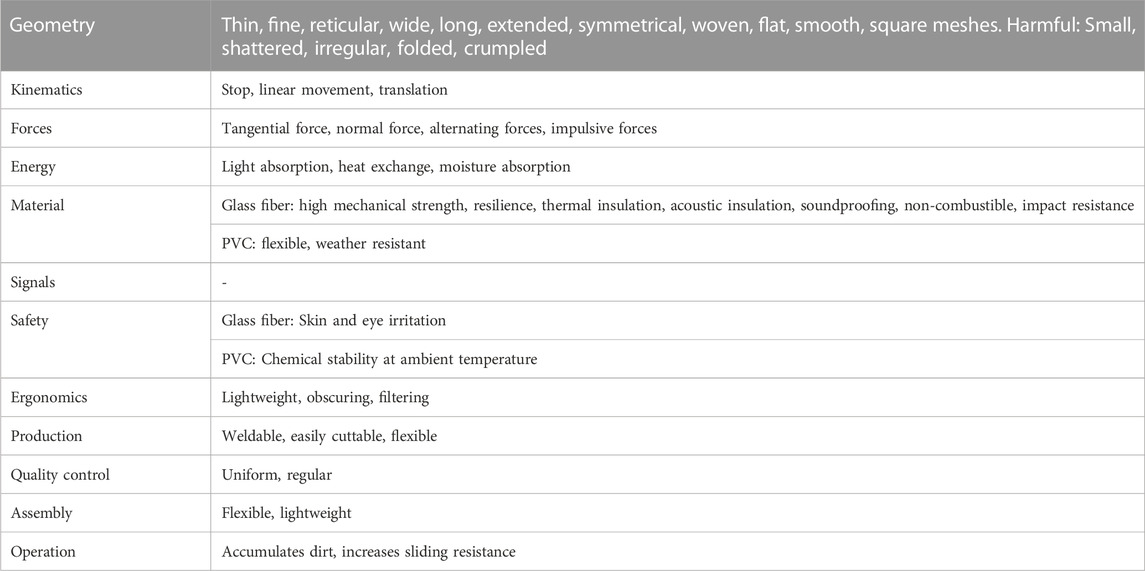
TABLE 4. List of mesh descriptors obtained from the application of Pahl and Beitz checklist for functions identification.
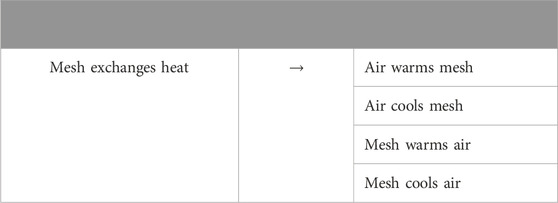
TABLE 5. Example of derivation of functions from the previously found mesh descriptor “Mesh exchanges heat”.
As mentioned in the previous section, analyzing a large number of terms with the present method would be cumbersome. Therefore, in agreement with the company, a screening of the most important terms was carried out to facilitate the method application. The final list of the most important functions and properties is reported in Table 7. From this set, keyword expansion is performed, and the outcome of this process is shown in Table 8.
The patent search engine used in this case is Google Patent (Google, 2023b), as it allows the introduction of a high number of multiple terms simultaneously in the search query. The search process was performed by considering each EK singularly and then with all their possible combinations according to Equation 1. For each search query, the results in terms of CPCs occurrence percentages out of the total patents were manually copied to an Excel file and stored, keeping track of the specific EKs input that generated them.
Then, thanks to a series of appositely designed VBA subroutines, the data were post-processed. A user interface, as shown in Figure 2, allows for the selection of the desired EKs combination, and the relative CPCs occurrences are shown in a graph. An example of such a graph is reported in Figure 3 for the combination “filter + reduced thickness + planar”. The overall DFD of the procedure followed is shown in Figure 4, while the complete titles for each resulting CPC code are reported in Table 1A in the appendix.
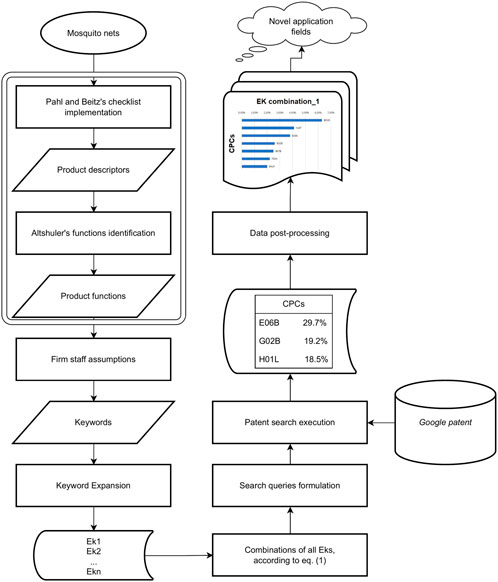
FIGURE 4. DFD of the procedure followed for the identification of mosquito net alternative uses, according to the methodology proposed by (Fiorineschi et al., 2018).
4 Results
Among all the possible combinations of EKs, the ones that were most descriptive of the product and had a subset of CPCs within them with higher recurrence rates than the others were selected in agreement with the company.
Moreover, to provide an alternative instrument for restricting the CPCs to be considered, a cumulative graph with the occurrence percentage of the most frequent categories has also been found. The results are shown in Figure 5. For the CPC titles, the reader is referred to the appendix.
In particular, each color represents the percentage of the CPCs occurrences out of the total occurrences of all CPCs, for each group of EK combinations characterized by the same number of terms (equal k). Therefore, in this case, six colors are present (n = 6). To avoid penalizing combinations where there were few absolute patents produced, this has been done separately for each group of equal numerosity. It is worth to point out that among the most recurring CPCs, the category E06B, related to the mosquito nets, is also found as expected.
The description of each selected CPC has been used as an external stimulus in brainstorming sessions that have been executed both by the firm’s staff alone and, on some occasions, with the participation of external groups of collaborators. Then, with those stimuli that did not generate any relevant idea, further patent searches are performed by introducing the specific CPC among the search queries, in addition to some of the most representative keywords, and analyzing the resulting patents. Therefore, through the utilization of this empirical method outlined, additional ideas are generated. In particular, brainstorming sessions have been beneficial in four cases, while patent searches in 2 cases.
The constrained set of CPCs that has been successfully employed to derive relevant results in terms of possible new mesh applications is provided in Table 9. It derives from the graph of Figure 5, in combination with the firm’s restriction on the EK combination options. The other CPCs that have been analyzed without having obtained satisfactory results are not explicitly reported. Therefore, the list of Table 9 is neither exhaustive nor the only one possible. In fact, it represents the result obtained from the specific firm staff, according to all the hypotheses and restrictions made.
The EK combination reported in the third column of Table 9 is the one that has been exploited during the process of CPC identification. Nevertheless, it is worth to point out that a single CPC can be found in more than one combination. As an example, the exact number of EKs combinations in which the CPCs of Figure 5 can be observed is reported in Table 10 for the sake of completeness.
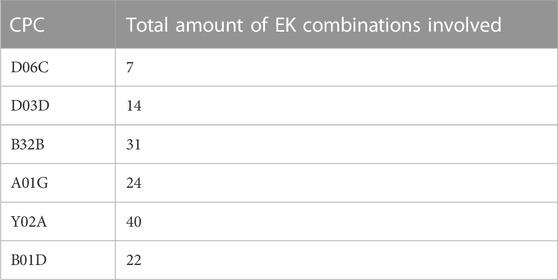
TABLE 10. Total amount of EKs combinations in which the most recurring CPCs of Figure 6 can be observed.
Six new possible application fields have been identified. The results are summarized in the fourth column of Table 9, together with the specific methodology for which the stimulus has been exploited, in the fifth column. As can be seen, patent search has been beneficial in two cases. For these two cases, the keywords and the patent examined (Roth, 2002; Lei and Lei, 2020) are reported in Table 11.
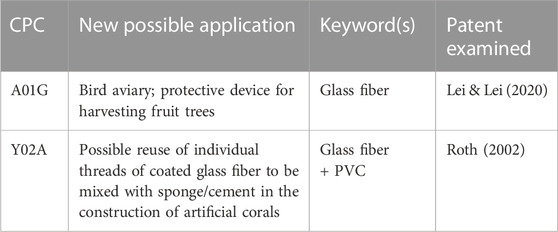
TABLE 11. Examined patents for the identification of alternative uses, starting from the retrieved CPCs.
Some of the alternative applications are more readily feasible than the others, in terms of different costs and additional processing that would be needed. Geogrids, found from the EK combination “filter + move + darken + reduced thickness + reticulate + planar”, are routinely used in the civil sector for reinforcing the soil and must meet certain standards of mechanical properties. Thus, a test campaign would be needed to understand if such properties are fulfilled by the net. In addition, it is possible to imagine that net scraps, which are therefore available in small pieces, are more difficult to use in a sector such as this, where the areas to be covered with the material can be very large.
The latter rationale makes the use of nets for vegetable or fruit tree protection crucial. To obtain a large single element when needed, it would therefore be necessary to perform at least one additional processing of joining individual scrap pieces.
The application identified by category Y02A, concerning the use of individual net threads to be mixed with cement in the construction of artificial corals, also seems difficult to apply. On one side, it would be necessary to have available individual net threads as scraps, which it is not the case. In addition, the type of application seems to be quite niche, although one might think of extending the use to similar types of components, such as decorative elements in general.
On the contrary, the possible uses as a fixing element during plaster application or as a reinforcing element for resin molding seem to be more promising. Depending on the waste used, however, additional processing may be required as well, to remove welded elements such as seals and/or plastic retaining buttons.
The other applications identified for the textile/manufacturing field, such as use as a reinforcing element for bags and backpacks or as a base for the creation of embroidery or carpets, also appear to be interesting and worthy of further investigation. In this regard, a fashion Maison located in Prato, Italy, has carried out a trial use of net scraps for the creation of a rigid corset, which is typically used in haute couture, formal wear, and lingerie. The bodice consists of seven garment pieces made of net (see Figure 6A), joined together inserting a corset boning (see Figure 6B) in every seam and a satin edge (see Figure 6C) for refinement. Once the entire bodice is assembled, a silk tulle is positioned and sewn onto the center part to create a ruffle (see Figure 7). An invisible zip is finally added at the center back to create the bodice opening. The dress is completed with a skirt made of the same tulle previously employed, attached at the bottom part of the corset. The result is visible in Figure 8.
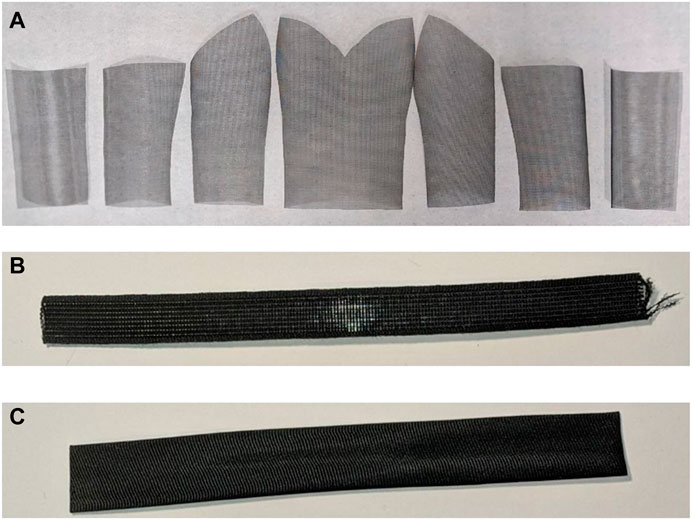
FIGURE 6. Net scraps for the trial use; (A) Seven garment pieces obtained from the net scrap; (B) Corset boning employed to strengthen the bodice shape; (C) Satin edge for the seams refinement.
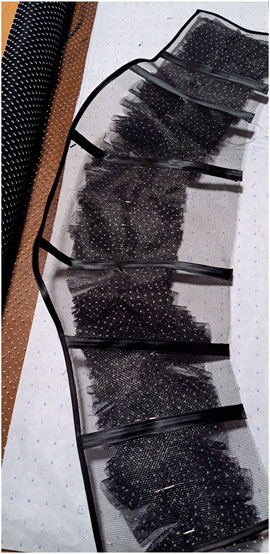
FIGURE 7. Bodice assembling phase. It is possible to observe the silk tulle positioning around the center part of the corset.
According to experts in the field, the material has proven to be excellent for this type of use, and possible alternative uses have also been suggested, such as a hardening structure in clothing and accessories or in the creation of hats, thanks to the material stiffness that allows it to maintain the desired shape once pressed on a specific mold. Additionally, due to its reticular structure, it is also considered an excellent base for creating embroidery, as previously supposed.
5 Discussion and conclusion
The main objective of this study was to explore alternative uses for mosquito net products, in order to mitigate their environmental impact by recovering waste generated during production or after their useful life has ended. To this goal, the study adopted the methodology proposed in (Fiorineschi et al., 2018) to provide useful guidelines for generating appropriate creative stimuli that could be leveraged during the design process. The quality of these new applications was then assessed by testing the technical feasibility of a specific solution. The requirement for adopting a supporting methodology in the process of generating these ideas was dictated by the fact that the firm staff had not previously faced the problem and were unsure of how to approach it. Therefore, in this specific case, employing a supporting method has proven to be beneficial for the firm goals of both reducing the net environmental impact and creating new business opportunities.
The method applied exploits the information obtained from the CPC codes in patents, which were in turn obtained by performing specific searches with different combinations of the starting product functions. Consequently, several stimuli for possible new applications of mosquito net waste were generated.
According to the manufacturer, some of the forecasted new uses are more difficult to realize than others, and further studies are needed to investigate. In particular, the utilization of mosquito nets in the geogrid field seems to be the most problematic. Assuming the product exhibits the appropriate mechanical properties for such purposes, it would be crucial to procure waste pieces that are as regular in shape as possible. This is particularly critical as the scraps always have different lengths. In addition, an analysis would be necessary to determine how to join the individual pieces without compromising the mechanical properties in the joining areas.
If the mechanical properties of the mosquito net were not suitable for the newly selected application, it would be necessary to make some adjustments to the net production process. Subsequently, tests would have to be carried out in agreement with the mesh manufacturer. As the company is fully equipped with its machinery for such production, it would be challenging to modify the basic materials. However, modest changes in the geometry could be considered, such as altering the thickness and size of the individual mesh elements. Two restrictions must be met for this to be viable: firstly, the mesh must not be too thick as it would limit the amount of mesh that can be contained in an aluminum profile, and secondly, the mesh must not have too large mesh elements as it would permit insects to pass through.
Instead, the most promising applications that do not require any modifications to the product are related to its use in fashion and craftsmanship. A preliminary test was carried out for making a dress and produced encouraging results. Furthermore, the textile industry already has established collection hubs for waste materials, which could also be useful for our application. Regarding the necessary cutting operations to remove any welded elements, these could be performed either using the existing machinery in the company or by the receiver of the product, as it is a simple operation that can be carried out with basic tools.
Although various stimuli were identified for possible alternative mosquito net uses, even promising ones, it is important to note that the results obtained largely rely on the assumptions made during the method’s implementation. The initial function identification phase was carried out as objectively as possible, by utilizing supporting tools such as Pahl and Beitz’s checklist, in combination with Altshuler’s function definition scheme. To obtain a more exhaustive description of the product in terms of properties and functions, other checklists that can be found in the literature (Bacciotti et al., 2016) can also be adopted. However, in order to speed up the process, the list of functions and properties was subsequently narrowed down to only the most representative ones. At this stage, the firm staff, who possesses a deep understanding of the product and its strengths and weaknesses, were chosen as the decision group. It is noteworthy that the selection of a different set of keywords would result in a different set of CPCs, and hence, different stimuli. Therefore, it is probable that some suggestions may be missed during this screening process, potentially resulting in the exclusion of some valuable opportunities. Moreover, a significant number of CPCs obtained as output were discarded influencing again the results, due to two other assumptions: the selection of a more representative set of EK combinations and a threshold value in terms of recurrence rates, below which the CPCs were not considered. Thus, the CPCs frequency in each patent search strongly influences the output. For this reason, the method could benefit in future applications from alternative methods of selecting CPCs. For instance, a cumulative graph of the most recurring CPCs could be obtained independently from which EK originated them. Further studies in this regard are needed to understand how this would influence the results.
The need for these assumptions in the method’s application arises from the challenges of managing a massive amount of information produced while performing a thorough search campaign in the patent database using all the starting keywords. According to Equation 1, the total number of queries needed to perform the search with all the functions in Table 6 would have been over 133,000 times greater than that of the functions in Table 7. This difficulty primarily results from the method’s implementation. Conducting such an extensive analysis using the available tools would require a significant amount of time with only minimal benefits to the results. In fact, the freely available patent search engine does not permit the automatic extrapolation of results in terms of CPCs, thus making it necessary to manually copy CPC occurrence values onto a worksheet and divide them correctly into cells for each search. This limitation proved to be a significant hurdle during the implementation phase. The use of an alternative paid search engine would most likely have simplified this task, allowing both the search with the various EK combinations and the extraction of the desired data to be automated. Further research is required to observe results obtained with different sets of product functions and compare them according to different metrics.
Furthermore, a crucial next step could be to validate the effectiveness of the method in generating novel ideas. Indeed, while it is possible to assert that the method was helpful in generating ideas of potential new product applications in this particular case (as the company was unable to approach the problem without any support), this study cannot rigorously demonstrate the general effectiveness of the method since it is unknown what quantity and quality of results would have been obtained if the same study had been conducted by two expert teams, with and without support. In fact, as reported in (Shah et al., 2000), additional experimental tests are necessary to assess the effectiveness of the proposed approach In particular, the same problem should be submitted to two different groups: a control group and a test group. The control group will be instructed to use a known method for addressing the problem (e.g., brainstorming) without support, while the test group will apply the same method but with the stimuli found in this study as inputs. Besides, it is crucial that the two groups are chosen as much “equivalent” as possible, in terms of backgrounds and technical skills. The quantity, quality and novelty of the solutions generated must then be evaluated to determine whether the use of the method is beneficial for implementing appropriate measures to reuse the product. Based on these considerations, it can be said that this exemplary application alone cannot demonstrate the general effectiveness of systematic approaches in new product applications identification, and further studies are needed to confirm this thesis, as already reported by other authors in this field.
Another valuable research could involve investigating which of the solutions identified through this method offers the most significant reduction of environmental impact. However, as this is beyond the scope of the present work, future studies will address this topic.
In conclusion, a demonstration of the applicability of the method proposed by (Fiorineschi et al., 2018) in an industrial context has been achieved in this work, obtaining some interesting alternative product applications. Hence, it can be considered as an example for those who will want to use the same method in the future for similar cases.
Data availability statement
The original contributions presented in the study are included in the article/Supplementary Material, further inquiries can be directed to the corresponding authors.
Author contributions
LB: supervision, manuscript review; RF, conceptualization, interpretation of results, manuscript review, supervision; MM: methodology, data collection and investigation, method application, interpretation of results, draft manuscript preparation; FR: conceptualization, methodology, interpretation of results, manuscript review, supervision. All authors listed have made a substantial, direct, and intellectual contribution to the work and approved it for publication. All authors contributed to the article and approved the submitted version.
Funding
This work has been realized thanks to Palagina s. r.l. And the University of Florence, within the FABER project, conceived and promoted by Fondazione Cassa di Risparmio di Firenze, in collaboration with Confindustria Firenze and Fondazione per la Ricerca and l’Innovazione of the University of Florence.
Conflict of interest
The author(s) RF declared that they were an editorial board member of Frontiers, at the time of submission. This had no impact on the peer review process and the final decision.
Author MM and LB were employed by Palagina s.r.l.
The remaining authors declare that the research was conducted in the absence of any commercial or financial relationships that could be construed as a potential conflict of interest.
Publisher’s note
All claims expressed in this article are solely those of the authors and do not necessarily represent those of their affiliated organizations, or those of the publisher, the editors and the reviewers. Any product that may be evaluated in this article, or claim that may be made by its manufacturer, is not guaranteed or endorsed by the publisher.
Abbreviations
CPC, Cooperative Patent Classification; EK, Expanded Keyword; IPD, International Patent Database; SAO, Subject-Action-Object; VBA, Visual Basic Application; DFD, Data Flow Diagram.
References
Abbas, A., Zhang, L., and Khan, S. U. (2014). A literature review on the state-of-the-art in patent analysis. World Pat. Inf. 37, 3–13. doi:10.1016/j.wpi.2013.12.006
Akers, L. (2003). The future of patent information--a user with a view. World Pat. Inf. 25 (4), 303–312. doi:10.1016/s0172-2190(03)00086-3
Bacciotti, D., Borgianni, Y., and Rotini, F. (2016). An original design approach for stimulating the ideation of new product features. Comput. Industry 75, 80–100. doi:10.1016/j.compind.2015.06.004
Bocken, N. M. P., de Pauw, I., Bakker, C., and van der Grinten, B. (2016). Product design and business model strategies for a circular economy. J. Industrial Prod. Eng. 33 (5), 308–320. doi:10.1080/21681015.2016.1172124
Cascini, G., and Rissone, P. “PAT-analyzer: A tool to speed-up patent analyses with a triz perspective,” in Proceedings of the ETRIA World Conference: TRIZ Future 2003, Aachen, Germany, November 2003.
Dewulf, S. (2011). Directed variation of properties for new or improved function product DNA – a base for connect and develop. Procedia Eng. 9, 646–652. doi:10.1016/j.proeng.2011.03.150
Fantoni, G., Apreda, R., Dell’Orletta, F., and Monge, M. (2013). Automatic extraction of function-behaviour-state information from patents. Adv. Eng. Inf. 27 (3), 317–334. doi:10.1016/j.aei.2013.04.004
Fiorineschi, L., Frillici, F. S., Gregori, G., and Rotini, F. (2018). Stimulating idea generation for new product applications. Int. J. Innovation Sci. 10 (4), 454–474. doi:10.1108/IJIS-09-2017-0099
Gadd, K. (2011). TRIZ for engineers: Enabling inventive problem solving. Hoboken, New Jersey, United States: John Wiley and Sons.
Geum, Y., and Park, Y. (2016). How to generate creative ideas for innovation: A hybrid approach of WordNet and morphological analysis. Technol. Forecast. Soc. Change 111, 176–187. doi:10.1016/j.techfore.2016.06.026
Gonçalves, M., Cardoso, C., and Badke-Schaub, P. (2014). What inspires designers? Preferences on inspirational approaches during idea generation. Des. Stud. 35 (1), 29–53. doi:10.1016/j.destud.2013.09.001
Google, L. P. S. B. (2023a). Google. Available online: https://www.google.com/?tbm=pts (Accessed 01 06, 2023).
Google, L. P. S. B. (2023b). Google images. Available online: https://images.google.com/?hl=xx-elmer&gws_rd=ssl (Accessed 04 08, 2023).
Howard, T. J., Culley, S., and Dekoninck, E. A. (2011). Reuse of ideas and concepts for creative stimuli in engineering design. J. Eng. Des. 22 (8), 565–581. doi:10.1080/09544821003598573
Howard, T. J., Dekoninck, E. A., and Culley, S. J. (2010). The use of creative stimuli at early stages of industrial product innovation. Res. Eng. Des. 21 (4), 263–274. doi:10.1007/s00163-010-0091-4
Jia, L.-Z., Wu, C.-L., Zhu, X.-H., and Tan, R.-H. (2018). Design by analogy: Achieving more patentable ideas from one creative design. Chin. J. Mech. Eng. 31 (1), 37. doi:10.1186/s10033-018-0234-5
Kamp Albæk, J., Shahbazi, S., McAloone, T. C., and Pigosso, D. C. A. (2020). Circularity evaluation of alternative concepts during early product design and development. Sustainability 12 (22), 9353. doi:10.3390/su12229353
Lei, M., and Lei, C. (2020). Defensive equipment. Available online: https://patents.google.com/patent/CN110839462A/en?oq=CN110839462A (Accessed 01 26, 2023).
Lin, W.-G., Hou, L., Lai, R., Zhao, N., and Wu, Y. (2012). Method to aid product innovation by TRIZ, DSM and patent knowledge. Appl. Mech. Mater., 201–202. doi:10.4028/www.scientific.net/AMM.201-202.825
Liu, H., Li, W., and Li, Y. (2021). A new computational method for acquiring effect knowledge to support product innovation. Knowledge-Based Syst. 231, 107410. doi:10.1016/j.knosys.2021.107410
Maccioni, L., Borgianni, Y., and Pigosso, D. C. A. (2021). Creativity in successful eco-design supported by ten original guidelines. Int. J. Des. Creativity Innovation 9 (4), 193–216. doi:10.1080/21650349.2021.1965033
McDonough, W., and Braungart, M. (2010). Cradle to cradle: Remaking the way we make things. New York, United States: North point press.
Moreno, M., Rios, C., Rowe, Z., and Charnley, F. (2016). A conceptual framework for circular design. Sustainability 8, 937. doi:10.3390/su8090937
Roth, R. (2002). Method of producing artificial fossil coral. Available online: https://patents.google.com/patent/US6355192B1/en?oq=US6355192B1 (Accessed 01 26, 2023).
Shah, J. J., Kulkarni, S. V., and Vargas-Hernandez, N. (2000). Evaluation of idea generation methods for conceptual design: Effectiveness metrics and design of experiments. J. Mech. Des. 122 (4), 377–384. doi:10.1115/1.1315592
Smith, G. F. (1998). Idea-generation techniques: A formulary of active ingredients. J. Creative Behav. 32 (2), 107–134. doi:10.1002/j.2162-6057.1998.tb00810.x
Srinivasan, V., Song, B., Luo, J., Subburaj, K., Elara, M. R., Blessing, L., et al. (2018). Does analogical distance affect performance of ideation? J. Mech. Des. Trans. ASME 140 (7). doi:10.1115/1.4040165
Tauqeer, M. A., and Bang, K. E. (2020). A novel systematic product ideation model using technology trends. Int. J. Innovation Sci. 12 (3), 303–321. doi:10.1108/IJIS-04-2020-0044
The Global Movement for Our Children’s Future - World Top 20 Project, (2022). Educate every child on the planet: The World Top 20 project. Available online: https://worldtop20.org/global-movement (Accessed 09 12, 2022).
Umeda, Y., Takeda, H., Tomiyama, T., and Yoshikawa, H. (1990). Function, behaviour, and structure. Appl. Artif. Intell. Eng. V 1, 177–193.
Unric (United Nations Regional Information Centre), (2019). Agenda 2030. Available online: https://unric.org/it/wp-content/uploads/sites/3/2019/11/Agenda-2030-Onu-italia.pdf (Accessed 02 02, 2023).
Verhaegen, P.-A., D’hondt, J., Vertommen, J., Dewulf, S., and Duflou, J. R. (2011). Searching for similar products through patent analysis. Procedia Eng. 9, 431–441. doi:10.1016/j.proeng.2011.03.131
Verhaegen, P. A., Vandevenne, D., and Duflou, J. R. “Systematically identifying reuse applications for supporting goods,” in Proceedings of the TRIZ Future Conference, Lisbon, Portugal, October 2012.
Yoon, J., Park, H., Seo, W., Lee, J.-M., Coh, B., and Kim, J. (2015). Technology opportunity discovery (tod) from existing technologies and products: A function-based tod framework. Technol. Forecast. Soc. Change 100, 153–167. doi:10.1016/j.techfore.2015.04.012
Zwicky, F. (1967). “The morphological approach to discovery, invention, research and construction,” in New methods of thought and procedure (Berlin, Germany: Springer), 273–297.
Appendix
The complete list of CPC titles encountered in the text and figures is reported in Table 1A below.
Keywords: circular economy, patent analysis, patent classification, idea generation, mosquito nets
Citation: Melani M, Furferi R, Rotini F and Barbieri L (2023) End of life of mosquito nets: searching for alternative uses through patent classification. Front. Manuf. Technol. 3:1172564. doi: 10.3389/fmtec.2023.1172564
Received: 23 February 2023; Accepted: 02 May 2023;
Published: 11 May 2023.
Edited by:
Qingjin Peng, University of Manitoba, CanadaReviewed by:
Jing Guo, Tianjin University of Finance and Economics, ChinaZhang Peng, Hebei University of Technology, China
Copyright © 2023 Melani, Furferi, Rotini and Barbieri. This is an open-access article distributed under the terms of the Creative Commons Attribution License (CC BY). The use, distribution or reproduction in other forums is permitted, provided the original author(s) and the copyright owner(s) are credited and that the original publication in this journal is cited, in accordance with accepted academic practice. No use, distribution or reproduction is permitted which does not comply with these terms.
*Correspondence: Marco Melani, marco.melani@unifi.it; Rocco Furferi, rocco.furferi@unifi.it
 Marco Melani1,2*
Marco Melani1,2*  Rocco Furferi
Rocco Furferi
